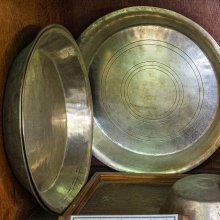Bhat, Bhaṭ: 12 definitions
Introduction:
Bhat means something in Hinduism, Sanskrit, Hindi, biology. If you want to know the exact meaning, history, etymology or English translation of this term then check out the descriptions on this page. Add your comment or reference to a book if you want to contribute to this summary article.
Images (photo gallery)
Biology (plants and animals)
Source: Wisdom Library: Local Names of Plants and DrugsBhat in the Marathi language is the name of a plant identified with Oryza sativa L. from the Poaceae (Grass) family. For the possible medicinal usage of bhat, you can check this page for potential sources and references, although be aware that any some or none of the side-effects may not be mentioned here, wether they be harmful or beneficial to health.
Bhat in the Hindi language is the name of a plant identified with Glycine max (L.) Merr. from the Fabaceae (Pea) family having the following synonyms: Dolichos sofa, Phaseolus max, Soja soja.
Source: Google Books: CRC World Dictionary (Regional names)1) Bhat in India is the name of a plant defined with Clerodendrum infortunatum in various botanical sources. This page contains potential references in Ayurveda, modern medicine, and other folk traditions or local practices It has the synonym Clerodendrum buchananii auct. (among others).
2) Bhat is also identified with Clerodendrum viscosum It has the synonym Clerodendrum infortunatum L. (etc.).
3) Bhat is also identified with Glycine max It has the synonym Soja viridis Savi (etc.).
4) Bhat is also identified with Oryza sativa It has the synonym Oryza sativa subsp. indica Kato (etc.).
Example references for further research on medicinal uses or toxicity (see latin names for full list):
· Flora Brasiliensis (1871)
· Chin. J. Rice Sci. (1996)
· Journal of Wuhan Botanical Research (1998)
· Kulturpflanze (1981)
· Botanisches Archiv (1922)
· Handbuch des Getreidebaus (1885)
If you are looking for specific details regarding Bhat, for example health benefits, side effects, pregnancy safety, extract dosage, chemical composition, diet and recipes, have a look at these references.

This sections includes definitions from the five kingdoms of living things: Animals, Plants, Fungi, Protists and Monera. It will include both the official binomial nomenclature (scientific names usually in Latin) as well as regional spellings and variants.
Languages of India and abroad
Sanskrit dictionary
Source: DDSA: The practical Sanskrit-English dictionaryBhaṭ (भट्).—I. 1 P. (bhaṭati, bhaṭita)
1) To nourish, foster, maintain.
2) To hire.
3) To receive wages. -II. 1 U. (bhaṭayati-te) To speak, converse.
Source: Cologne Digital Sanskrit Dictionaries: Shabda-Sagara Sanskrit-English DictionaryBhaṭ (भट्).—r. 1st. cl. (bhaṭati) 1. To hold or cherish. 2. To hire or maintain. 3. To speak. (i) bhaṭi r. 10th cl. (bhaṃṭayati) To deceive.
--- OR ---
Bhāt (भात्).—mfn. (-bhān-bhāntī or -bhātī-bhāt) Shining splendid. E. bhā to shine, śatṛ aff.
Source: Cologne Digital Sanskrit Dictionaries: Benfey Sanskrit-English DictionaryBhaṭ (भट्).—i. 1, [Parasmaipada.] 1. To hive. 2. To nourish. 3. To speak. [Causal.] of 1. 2. bhāṭaya, of 3. bhaṭaya.
Source: Cologne Digital Sanskrit Dictionaries: Cappeller Sanskrit-English DictionaryBhaṭ (भट्).—bhāṭayati hire.
Source: Cologne Digital Sanskrit Dictionaries: Monier-Williams Sanskrit-English DictionaryBhaṭ (भट्):—[class] 1. [Parasmaipada] bhaṭati, to hire, nourish, maintain, [Dhātupāṭha ix, 20];
— [class] 10. [Parasmaipada] bhaṭayati, to speak, converse, [xix, 18] :—[Causal] -bhāṭayati, to hire, [cf. Lexicographers, esp. such as amarasiṃha, halāyudha, hemacandra, etc.] ([probably] [Nominal verb] [from] next).
Source: Cologne Digital Sanskrit Dictionaries: Yates Sanskrit-English Dictionary1) Bhaṭ (भट्):—bhaṭati 1. a. To hold or cherish; to hire or maintain; to speak. (i, ka) bhaṇṭayati 10. a. To deceive.
2) Bhāt (भात्):—[(t-ntī-t) p.] Shining.
Source: DDSA: Paia-sadda-mahannavo; a comprehensive Prakrit Hindi dictionary (S)Bhāt (भात्) in the Sanskrit language is related to the Prakrit word: Bhaṃta.
[Sanskrit to German]
Sanskrit, also spelled संस्कृतम् (saṃskṛtam), is an ancient language of India commonly seen as the grandmother of the Indo-European language family (even English!). Closely allied with Prakrit and Pali, Sanskrit is more exhaustive in both grammar and terms and has the most extensive collection of literature in the world, greatly surpassing its sister-languages Greek and Latin.
Hindi dictionary
Source: DDSA: A practical Hindi-English dictionary1) Bhat in Hindi refers in English to:—(nm) a soldier, a warrior..—bhat (भट) is alternatively transliterated as Bhaṭa.
2) Bhat in Hindi refers in English to:—(nm) a bard, minstrel; sycophant..—bhat (भाट) is alternatively transliterated as Bhāṭa.
3) Bhat in Hindi refers in English to:—(nm) boiled rice; presents (on special occasions given to daughters, nieces, etc.); —[dena] to send presents etc.; to have to arrange feast (as a punishment)..—bhat (भात) is alternatively transliterated as Bhāta.
...
See also (Relevant definitions)
Starts with (+431): Bhat kerela, Bhat-ghagari, Bhat-karela, Bhat-kerala, Bhat-meteka, Bhat-sar, Bhata, Bhata Pado, Bhata Sutta, Bhata-Kana-Kana-Kara-Dishim, Bhata-manushya, Bhata-pado, Bhatabaasee, Bhatabalagra, Bhatabasi, Bhatabharu, Bhatabhata, Bhatabhata, Bhatabhata, Bhatabhata.
Ends with: Dabhat, Dev-bhat, Dhatubhat, Pratibhat, Suprabhat, Udbhat, Upakumbhat, Vibhat, Vishrambhat.
Full-text (+28): Bhanta, Bhata, Nirbhatsayati, Vibhat, Bhati, Bhat-karela, Bhat-sar, Bhat kerela, Bhartsita, Bhats, Dev-bhat, Bhatiya, Nibhati, Bhatiyadipika, Upapattimat, Uddesaka, Bhataprakasha, Bhataprakashika, Dharabhrit, Varbhata.
Relevant text
Search found 14 books and stories containing Bhat, Bhaṭ, Bhāt, Bhaat; (plurals include: Bhats, Bhaṭs, Bhāts, Bhaats). You can also click to the full overview containing English textual excerpts. Below are direct links for the most relevant articles:
Puppetry in Assam (by Gitali Saikia)
Legend related to puppetry < [Chapter 3]
Chapter 5: Comparative Study Of Indian Puppet And Assam’s Puppet
Puppetry in India (a): String puppet or Marionette < [Chapter 2]
The Lambadis and Culture Contact < [September 1945]
LAL DED (Kashmiri Poetess) < [July – September, 2003]
Sochi Raut Roy < [March 1944]
Diaspora of Bhuta (Daiva) worshipping cult—India and Indonesia (by Shilpa V. Sonawane)
Karmic Astrology—a Study (by Sunita Anant Chavan)
Dasarupaka (critical study) (by Anuru Ranjan Mishra)
Introduction to the Īhāmṛga type of Drama < [Chapter 9 - Īhāmṛga (critical study)]
Introduction to the Utsṛṣṭikāṅka type of Drama < [Chapter 8 - Utsṛṣṭikāṅka (critical study)]
The Tattvasangraha [with commentary] (by Ganganatha Jha)
Verse 2079 < [Chapter 23 - External World]
